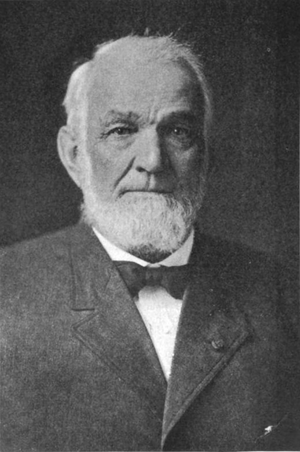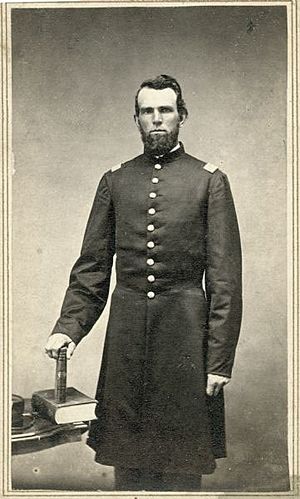Clement Warner facts for kids
Quick facts for kids
Clement E. Warner
|
|
|---|---|
 |
|
| Member of the Wisconsin Senate from the 11th district |
|
| In office January 7, 1867 – January 4, 1869 |
|
| Preceded by | Willard H. Chandler |
| Succeeded by | Nelson Williams |
| Member of the Wisconsin State Assembly from the Dane 2nd district |
|
| In office January 1, 1883 – January 5, 1885 |
|
| Preceded by | Elisha W. Keyes |
| Succeeded by | Charles E. Buell |
| Personal details | |
| Born | February 23, 1836 Batavia, New York |
| Died | May 20, 1916 (aged 80) Windsor, Wisconsin |
| Cause of death | Kidney failure |
| Resting place | Windsor Congregational Cemetery, Windsor, Wisconsin |
| Political party | Republican |
| Spouse |
Eliza Noble
(m. 1867; died 1916) |
| Children |
|
| Relatives | Fred Risser (grandson-in-law) Fred A. Risser (great-grandson) |
| Military service | |
| Allegiance | |
| Branch/service | Union Army |
| Years of service | 1864–1865 |
| Rank | |
| Commands | 36th Reg. Wis. Vol. Infantry |
| Battles/wars | American Civil War
|
Clement Edson Warner (February 23, 1836 – May 20, 1916) was an American farmer, a Republican politician, and an officer in the Union Army during the American Civil War. He served with the 36th Wisconsin Infantry Regiment and led the regiment near the end of the war. Later, he became a politician in Wisconsin, serving in the Wisconsin State Senate (1867–1869) and the Assembly (1883–1885) for Dane County.
Contents
Early Life and Education
Clement Warner was born in Batavia, New York, on February 23, 1836. When he was 16, in 1852, his family moved west to a farm near Windsor, in Dane County, Wisconsin. He went to public schools in New York and later attended the Sun Prairie Seminary. In 1857, he studied at the University of Wisconsin. Even though he taught school for a few years, he loved farming and decided to make it his main job.
Civil War Service
When the American Civil War started, Clement Warner was drafted, but he arranged for someone else to take his place because his personal affairs were not ready. In 1864, he felt prepared to serve. The Governor of Wisconsin asked him to help gather soldiers for a new group called the 36th Wisconsin Infantry Regiment. Warner successfully recruited a company of volunteers and became a Captain of Company B. His regiment joined the war on March 23, 1864, and was sent to Washington, D.C., to fight in the eastern part of the war.
Fighting in the Overland Campaign
Warner's regiment arrived during General Ulysses S. Grant's Overland Campaign, a series of battles. They joined the main Union army, called the Army of the Potomac, at Spotsylvania County, Virginia. On May 19, they became part of the II Corps. They marched and fought in several battles, including the Battle of North Anna and the Battle of Totopotomoy Creek.
On June 1, 1864, a big fight started at the Battle of Cold Harbor. Warner's group was ordered to make a fake attack to keep the Confederate soldiers busy. Captain Warner led his skirmishers (small groups of soldiers) forward under heavy fire. They succeeded in pushing back the enemy, but many of his men were killed, wounded, or captured.
On June 3, the 36th Wisconsin joined a huge attack on the enemy's strong defenses. They suffered many losses, and their leader, Colonel Haskell, was killed. Because of this, Captain Warner was promoted to major.
The Siege of Petersburg
After Cold Harbor, Warner's corps moved to Petersburg. They found the Confederate army strongly dug in around the city, starting the Siege of Petersburg. On June 18, the 36th Wisconsin attacked the enemy lines. Their new colonel was killed, and the lieutenant colonel was wounded. This meant that Major Warner took command of the regiment.
The fighting continued, and on June 21, Warner's regiment tried to cut off a Confederate supply line. They faced heavy fire and many of their men were captured. Major Warner was later promoted to lieutenant colonel and continued to lead the regiment. In just 37 days, the regiment had lost many soldiers, including two colonels.
In July, the Union army tried to trick the Confederates by making a fake attack towards Richmond, Virginia. This was to make the enemy move soldiers away from Petersburg. Warner's corps took part in this plan, called the First Battle of Deep Bottom. It worked, and the Confederates sent many soldiers to Richmond.
Two weeks later, Warner's corps made another fake attack at the Second Battle of Deep Bottom. During this battle, Lieutenant Colonel Warner was shot. The bullet shattered his arm, and it had to be removed. He spent the rest of 1864 recovering from his injury.
Warner officially became the commander of the 36th Wisconsin in October, but he couldn't return to duty until December. In February 1865, his regiment moved to Hatcher's Run. Warner was officially promoted to colonel during this time.
End of the War: Appomattox Campaign
On March 25, 1865, General Grant ordered the final attack on Petersburg. Warner's corps advanced, pushing the Confederates back. On April 2, they learned that the Confederates had left Petersburg.
The 36th Wisconsin joined the chase after the Confederate army. They fought in smaller battles like the Battle of High Bridge and the Battle of Cumberland Church. Their constant pursuit helped the Union army trap the Confederates. On April 9, 1865, Colonel Warner was present at the surrender of the main Confederate army at the Battle of Appomattox Court House. This marked the end of the Civil War.
After the war, Warner's regiment returned to Washington, D.C., and took part in a big parade called the Grand Review of the Armies. They were officially released from service on July 12, 1865.
Public Service and Politics
After the war, Warner went back to his farm and got involved in politics. In 1866, he was elected to the Wisconsin State Senate. He served on important committees dealing with military affairs, education, and public lands. He decided not to run for a second term.
Later, in 1881, Warner ran for the Wisconsin State Assembly again and won by a small number of votes. In the Assembly, he worked on a committee for charitable and penal institutions. He did not run for re-election in 1884.
Later Life and Family
After leaving the state government, Clement Warner stayed active in his community. He served on the county insane asylum board, as a jury commissioner, and helped soldiers in need. He also played a key role in starting a public high school in Windsor.
Clement Warner passed away on May 20, 1916, at his home in Windsor, Wisconsin, due to kidney failure.
In 1867, Clement Warner married Eliza Noble. They had seven children together, though one died as a baby.
His oldest son, Ernest Noble Warner, also became a politician and served in the Wisconsin State Assembly in 1905. Clement Warner's great-grandson, Fred A. Risser, became the longest-serving member in the history of the Wisconsin Legislature, representing Dane County in the Wisconsin Senate for many years.
Images for kids


